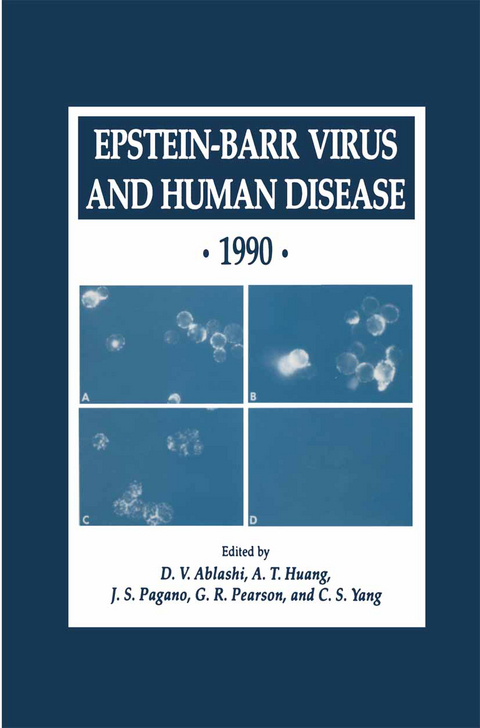
Epstein-Barr Virus and Human Disease · 1990
Humana Press Inc. (Verlag)
978-0-89603-221-7 (ISBN)
The Epstein-Barr virus (EBV), isolated in 1966, continues to draw worldwide attention as an important human pathogen. Its impor tance is largely related to the continuing accumulation of evidence that implicates EBV as an etiological factor for certain types of human cancer. More recent investigations on this virus have focused on the identity of the viral genes responsible for the different disease mani festations observed following viral infection. It is hoped that by thorough investigation of this virus, clues to how cancer develops from a normal cell will surface. In addition, many of the gene products are now being exploited for the development of new and more sensitive tests for the diagnosis and clinical management of individu als with EBV -associated diseases. Thus, studies on this virus continue to provide new information of importance to our understanding of the malignant process. In an effort to attract both basic and clinical scientists to the same meeting for purposes of scientific exchange and fostering a closer interaction between these individuals, a series of international symposia was initiated in 1984. The first meeting was held in Loutraki, Greece, and was attended by approximately 100 participants. The second international symposium was held in St. Petersburg, Florida, in 1986, and was attended by approximately twice as many partici pants as attended the Loutraki meeting.
I. Molecular Biology of EBV.- Replication of the Epstein-Barr Virus in Lymphoid and Epithelial Cells.- The Productive Cycle Defect in Raji EBV is Not Solely Due to Absence of the BALF2 Gene.- Interference of EBNA-1 Binding to ori -P by Cellular Proteins (Anti-EBNA1).- How ZEBRA, a Weak Transactivator, Exerts Strong Biologic Effects.- EBNA-2 Transactivation of CD23.- EBNA-2 Transactivation of LMP1.- A New Lymphoid-Specific Epstein-Barr Virus Enhancer Is Transactivated by EBNA-2.- Transcriptional Regulation of an Epstein-Barr Virus Nuclear Antigen Gene Promoter.- EBNA-2 Influences Promoter Function in Burkitt Lymphoma Cells.- Functional Characterization of Epstein-Barr Virus DNA Polymerase by In Vitro Transcription-Translation of Cloned Genes.- Epstein-Barr Virus Recombinants: Use of Positive Selection Markers to Rescue Mutants in EBV Negative B Lymphoma Cells.- Characterization of EBV DNase Related Transcripts.- The PstI- Repeats of the Epstein-Ban Virus Encode a Protein with a Molecular Weight between 115,000 and 140,000.- The EBV BRLF1 Protein Has Sequence and Functional Similarity with the C-myb Oncogene.- Heterodimers of the ZEBRA and fos Basic Domains Bind DNA with the Specificity of ZEBRA.- Relationship of the EBV Lytic Activator Zta to the bZIP Family of Cellular Transactivators.- Trans-Regulation of the Early MS Gene of EBV and Its Depen-dence on the Host Cell.- Induction and Regulation of Expression of the Epstein-Barr Virus DNA Polymerase Gene.- Recombinant EBV Antigens and Their Diagnostic Value.- Epstein-Barr Virus Associated Histio-Lymphoproliferative Syndromes in Two European Families.- II. Pathobiology of EBV.- Role of Cytokines in EBV-Infected Cell Growth.- Epstein-Barr Virus Variants at Mucosal Surfaces.- Epstein-Barr Virus Infection and Monokine Synthesis.- Transcription from Bam HI A in NPC.- Characterisation of the Novel “18.8” Family of Transcripts from NPC Tumours.- EBER1 Small Nuclear RNA in Malignancy: A Morphologically Distinctive Target for Detection of EBV in Formalin-Fixed Paraffin-Embedded Specimens.- Tumorigenicity and Organization of the Terminal Region of the Epstein-Barr Virus (EBV) Genome in LCLs Derived from Carcinogen-Treated Lymphocytes.- Expression of EBNA2 and an EBNA5 Protein from Alternatively Spliced mRNA’s.- III. Immunology of EBV.- EBV Humoral Immunology: 1966-1990.- The Role of EBNA Proteins as a Target for EBV-Specific T Cell Lysis.- Role of the Epstein-Barr Virus (EBV) Glycoprotein gp350 as a Target Antigen for EBV-Specific Cellular Killing.- Mapping of B and T Cell Epitopes on the Epstein-Barr Virus Receptor Ligand gp340: A Candidate Subunit Vaccine.- Identification of T Helper Cell Epitopes on gp 340.- Reactivity of EBV Type A-Specific Cytotoxic T-Cells.- DNA Sequence Variation in EBV-Encoded T-Cell Epitopes.- Recombinant Adenoviruses Which Express the EBV Major Membrane Antigen gp340/220 Induce Persistent EBVNeutralizing Antibodies in Rabbits.- Inhibition of the EBV Lytic Cycle by Sequence Specific Antisense Oligonucleotides.- IV. EBV Associated Lymphoproliferative Disorders.- Advances in the Understanding of EBV Associated Lympho-proliferative Disorders.- The Association of Epstein-Barr Virus with Lymphoproliferative Disorders: A Re-Evaluation Using the Polymerase Chain Reaction.- Absence of EBV in Reed-Sternberg Cells in Many Cases of Hodgkin’s Disease.- EBV and Granular Lymphocytes Proliferation.- EBV Transmission and Expression Among Patients with PTLD.- SCID Mouse Model of Virus-Induced Lymphomagenesis of Immunodeficient Humans.- Patients with Psoriasis Have High SerumReactivity with EBNA2B.- EBV Activation by Anti-IgG-Triggered, Second Messenger Pathways.- V. Advances in NPC.- Nasopharyngeal Carcinoma:1990.- In Situ Analysis of Epstein-Barr Viral Expression in Nasopharyngeal Carcinoma.- Interaction of EBV Genes with Human Epithelial Cells.- Studies on the Terminal Protein I (TP1) of the Epstein-Barr Virus and the Anti-TP Immune Response in Humans.- Diagnosis of Nasopharyngeal Carcinoma Using the Epstein-Barr Virus Coded Alkaline DNase Membrane Antigen and Thymidine Kinase.- Detection of Anti-Epstein Barr Virus Transactivator (ZEBRA) Antibodies in Sera from Patients with Nasopharyngeal Carcinoma.- EBV pp58 DNase Expressed in the Baculovirus System May Improve the Diagnosis of NPC.- Efficacy of Exfoliative Cytology in Diagnosis of Nasopharyngeal Carcinoma.- Neoadjuvant Approach with Bleomycin, Epirubicin and Cisplaten in the Treatment of Locally Advanced UCNT.- VI. Clinical Aspects of NPC.- Pathogenesis of Nasopharyngeal Carcinoma.- EBV Genome Oranization in Lymphoblastoid Cell Lines Established Following Enhancement with Aflatoxin B1 and Relevance to Nasopharyngeal Carcinoma.- Preliminary Results of HLA Class I and Class II Antigens in Chinese with Nasopharyngeal Carcinoma.- Radiation Therapy of Nasopharyngeal Cancer in Taiwan University Hospital 1958-1989.- 417 Chemotherapy in Undifferentiated Type Nasopharyngeal Carci-noma (UCNT).- Neoadjuvant Chemotherapy Plus Radiotherapy Versus Radiotherapy Alone in Nasopharyngeal Cancer.- The Role of Surgery in the Management of Recurrent Primary Nasopharyngeal Carcinoma.- Randomized Controlled Studies on Immunotherapy of Nasopharyngeal Carcinoma with OK-432.- A Preliminary Study on the Immunogenicity in Rabbits and in Human Volunteers: Recombinant Vaccinia Virus Expressing Epstein-Barr VirusMembrane Antigen.- List of Participants.
...can be recommended as containing a wealth of source material, not otherwise easily accessible.-Reviews in Medical Virology
| Erscheint lt. Verlag | 11.11.1991 |
|---|---|
| Reihe/Serie | Experimental Biology and Medicine ; 24 |
| Zusatzinfo | XLIV, 455 p. |
| Verlagsort | Totowa, NJ |
| Sprache | englisch |
| Maße | 155 x 235 mm |
| Themenwelt | Medizin / Pharmazie ► Medizinische Fachgebiete ► Mikrobiologie / Infektologie / Reisemedizin |
| Medizin / Pharmazie ► Studium | |
| Naturwissenschaften ► Biologie ► Mikrobiologie / Immunologie | |
| Naturwissenschaften ► Biologie ► Zellbiologie | |
| ISBN-10 | 0-89603-221-3 / 0896032213 |
| ISBN-13 | 978-0-89603-221-7 / 9780896032217 |
| Zustand | Neuware |
| Haben Sie eine Frage zum Produkt? |
aus dem Bereich


